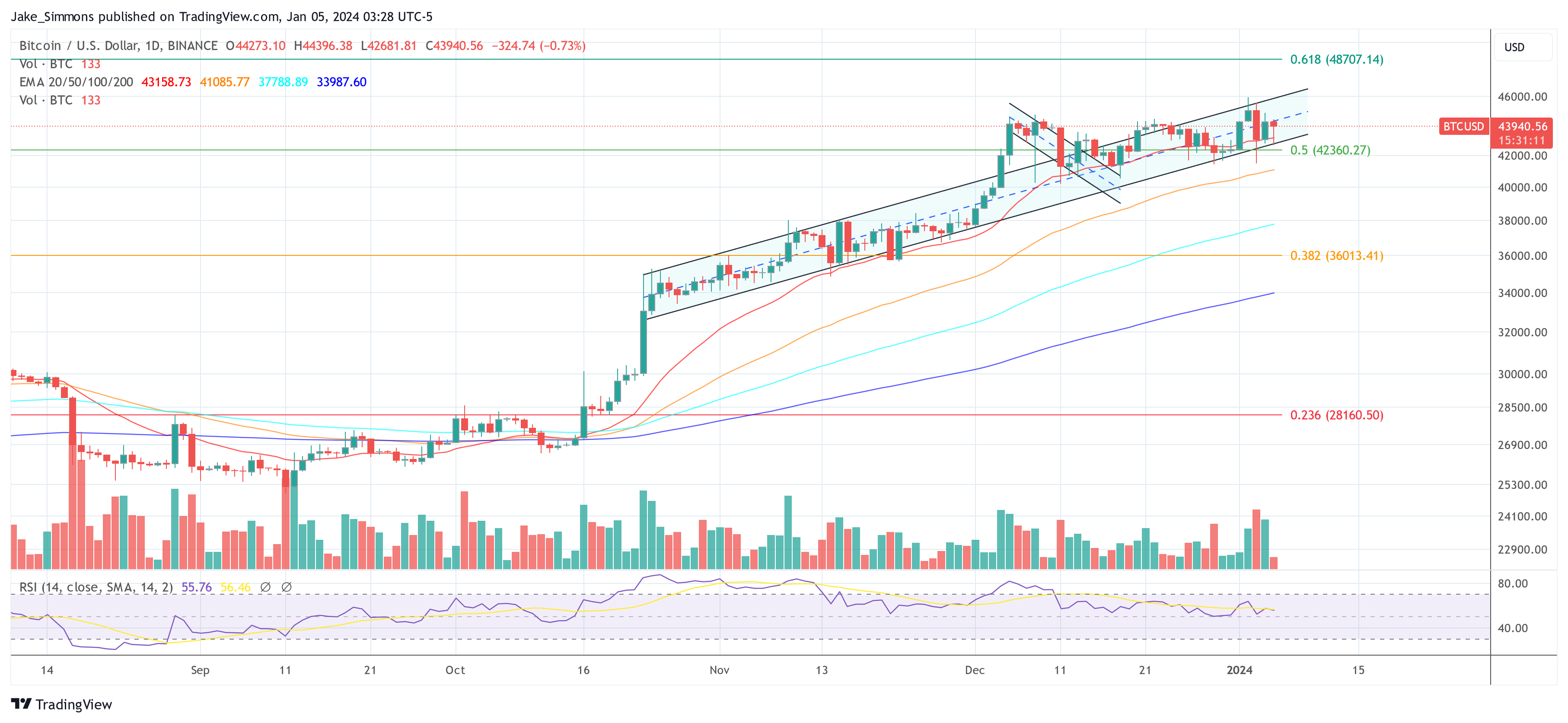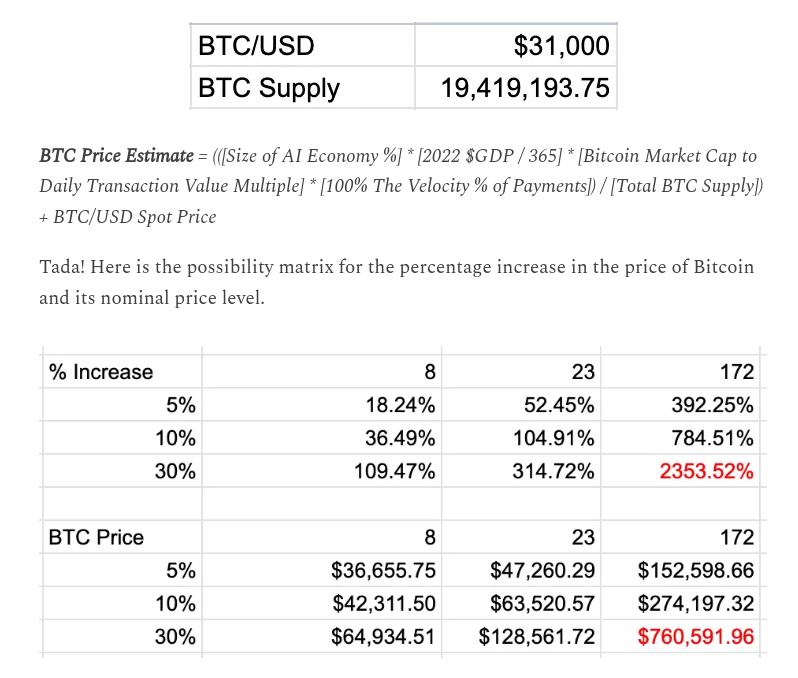 B2Broker is a premier provider of liquidity solutions, white-label platforms, CRM systems and advanced trading mechanisms. Founded in 2014, B2Broker has consistently added new features and tools to its expansive liquidity and white-label offerings. With the contribution of B2Broker’s sibling companies – B2BinPay, B2Core and B2Trader, the group delivers a comprehensive suite of B2B brokerage […]
B2Broker is a premier provider of liquidity solutions, white-label platforms, CRM systems and advanced trading mechanisms. Founded in 2014, B2Broker has consistently added new features and tools to its expansive liquidity and white-label offerings. With the contribution of B2Broker’s sibling companies – B2BinPay, B2Core and B2Trader, the group delivers a comprehensive suite of B2B brokerage […]
Source link
Arthur
Arthur Hayes, the founder of BitMEX, in his latest essay, presents a foreboding prediction for the Bitcoin market in March, anticipating a severe correction of 30-40%. His detailed analysis, rooted in a deep understanding of market dynamics, outlines the complexities and driving factors behind this expected crash, respectively healthy but deep correction.
Hayes begins his discourse with a cautionary reminder of the nascent state of the crypto bull market, warning enthusiasts not to be overly carried away. “The crypto bull market is in its early stages, and we must not get carried away with our enthusiasm,” he says, highlighting the uncertain journey towards the inevitable collapse of the fiat financial system.
Why The Bitcoin Price Could Fall 40% In March
His prediction revolves around three key financial events and indicators converging in March. Hayes first points to the anticipated decline in the Reverse Repo Program (RRP) Balance to a critical level of $200 billion, a scenario he believes will trigger market anxiety about future sources of dollar liquidity. He describes this threshold as a moment of reckoning, “When this number gets close to zero… the market will wonder what is next,” underscoring the gravity of this anticipated development.
The second pivotal factor is the fate of the Bank Term Funding Program (BTFP), which is due to expire on March 12th. Hayes portrays this as a significant test for the financial system, speculating on the decision-making process of the US Treasury in the face of potential liquidity crises among banks. He articulates the market’s anticipatory stance, suggesting that “the market will start getting inquisitive many weeks before about whether or not the banks will continue receiving this lifeline.”
The final piece in Hayes’ forecast is the Federal Reserve’s meeting on March 20th, where a rate cut is expected. This decision, in Hayes’ view, is crucial for setting market expectations and influencing the dynamics surrounding dollar liquidity provision by the Fed and the US Treasury Department.
Hayes then delves deeper into his tactical trading strategy in response to these events, detailing his plans to short the crypto market using Bitcoin puts. He articulates his approach, saying, “I will look to buy a sizable put option position on Bitcoin around this time,” signaling his preparedness to leverage the anticipated market shift.
An important aspect of Hayes’ analysis is the potential impact of the US-listed spot Bitcoin Exchange Traded Funds (ETFs). He argues that the anticipation of substantial fiat capital inflows into these spot ETFs could initially propel Bitcoin’s price to soaring highs. However, he warns that this upsurge could be followed by a dramatic correction, exacerbated by a liquidity squeeze.
“Imagine if the anticipation of hundreds of billions of fiat flowing into these ETFs at a future date propels Bitcoin above $60,000,” he says, illustrating the potential for a steep decline. Hayes explains that a market already heightened by ETF speculation would be particularly vulnerable to a sharp correction, potentially worsening the downturn to 30-40% in the event of a liquidity crunch.
How Hayes Will Trade This Scenario
Hayes then shifts to discuss his tactical trading decisions in response to these indicators. He shares his plan to initially short the crypto market using Bitcoin puts, followed by a return to selling US Treasury bills and acquiring more Bitcoin and cryptocurrencies. In explaining his approach, Hayes states, “I will look to buy a sizable put option position on Bitcoin around this time,” indicating his readiness to capitalize on the predicted market downturn.
Furthermore, Hayes details his strategy for Bitcoin puts, explaining the rationale behind choosing puts expiring on June 28th and his approach to selecting the strike price. He emphasizes the importance of timing and market dynamics, noting, “I expect Bitcoin to experience a healthy […] correction from whatever level it has attained by early March.”
In his conclusion, Hayes contemplates various scenarios that could play out differently from his predictions. He considers the implications of a slower decline in the RRP, a potential extension of the BTFP by Yellen, or alternative outcomes of the Fed’s March meeting. He notes that each of these scenarios could lead to different market behaviors, necessitating adjustments in his trading approach.
At press time, BTC traded at $43,940.

Featured image from YouTube / What Bitcoin Did, chart from TradingView.com
Disclaimer: The article is provided for educational purposes only. It does not represent the opinions of NewsBTC on whether to buy, sell or hold any investments and naturally investing carries risks. You are advised to conduct your own research before making any investment decisions. Use information provided on this website entirely at your own risk.
Arthur Hayes believes big banks will make stablecoin issuers like Tether obsolete

Big banks are poised to enter and potentially dominate the stablecoin market, overshadowing current leaders like Tether, according to former BitMEX co-founder Arthur Hayes.
In a recent interview with Unchained’s Laura Shin, Hayes said that centralized stablecoins have found a lucrative niche due to the reluctance of traditional banks to engage in similar activities.
However, he foresees a possible disruption, as banks might eventually enter the market with their own digital currencies. Hayes predicted that once banks recognize the profit potential in this domain, they will quickly move to dominate it, leveraging their existing infrastructure and customer trust.
Existential threat for stablecoin issuers
Hayes observed that despite Tether’s success in establishing itself as a leading fiat-collateralized stablecoin, the fundamental business model it employs is one that traditional banks could easily adopt and potentially excel in.
Hayes said that centralized stablecoins like Tether have thrived due to a gap left by traditional banking systems.
Tether, for instance, generates significant profits by exploiting interest rate differentials between dollar deposits and U.S. treasury bills, a business model that banks have refused to engage in due to political or regulatory constraints.
According to Hayes:
“[Stablecoin issuers] don’t have any defensible business because they use banks to custody their funds, which allows them to trade debt instruments.”
However, Hayes predicts a shift where major banks could launch their digital currencies, potentially rendering services like Tether obsolete.
He said that once banks are given the green light to engage with the digital assets sector, they have the necessary comprehensive financial networks and regulatory compliance frameworks to hit the ground running.
He speculated that if banks like JP Morgan Chase were to launch their own stablecoin, they could easily leverage their established reputations and global reach to quickly gain a significant market share, thereby impacting the dominance of current providers such as Tether.
Bitcoin and AI
The conversation also touched on the role of Bitcoin (BTC) as the preferred currency for AI. Hayes argued that money, at its core, is a form of energy transformation.
In his view, Bitcoin, being a direct product of energy expenditure (through mining), represents the purest form of monetary energy. This makes it uniquely suited for AI systems, which prioritize efficient energy management and operate in a purely computational realm.
Hayes further elaborated that AI systems, in their quest for efficiency and autonomy, would naturally gravitate towards a currency that embodies these principles. Bitcoin, with its decentralized, energy-based foundation, fits this criterion perfectly.
The former CEO and co-founder of crypto exchange BitMEX, Arthur Hayes, has shared his thoughts on what could lead to Bitcoin’s downfall. His recent comment also echoes the reservation that the crypto founder has about the potential launch of Spot Bitcoin ETFs.
TradFi Could Lead To Bitcoin’s Downfall
In his last article for the year, Hayes stated that TradFi asset managers would “completely destroy Bitcoin” if the ETFs managed by them were a huge success. He made this assertion as he alluded to Bitcoin’s uniqueness. Hayes mentioned that the foremost crypto token is different from “every other monetary instrument humanity has ever used.”
Due to Bitcoin’s uniqueness, Hayes believes that it wasn’t created to be in the hands of these asset managers. As such, they could end up destroying the crypto token, especially in a world where the world’s largest asset managers end up holding all the Bitcoin in circulation. If that were to happen, these firms would end up storing these crypto tokens, which shouldn’t be so in Hayes’ opinion.
The BitMEX co-founder noted that Bitcoin “only exists if it moves” and that it will “die” if it isn’t used. His stance stems from the fact that he sees Bitcoin more as an asset that is meant to be actively traded rather than just being a store of value. He also highlighted the fact that the Bitcoin network would also die if this were to happen.
Miners are known to earn transaction fees from the network being utilized. However, if these tokens were no longer traded but all stored up, these miners would have no choice but to wind up their operations. Without these miners, “the network dies, and Bitcoin vanishes,” Hayes asserted.
BTC maintains $43,000 level | Source: BTCUSD on Tradingview.com
Hayes’ Reservations About A Spot Bitcoin ETF
Arthur Hayes’ latest comment comes ahead of a potential approval of the pending Spot Bitcoin ETF applications. The former BitMEX CEO has previously made his reservations known about these funds and their issuers. Then, he mentioned that these TradFi institutions weren’t bullish on Bitcoin but were simply making this move to become “crypto gatekeepers.”
Hayes also went as far as to discuss how these firms’ interest in Bitcoin goes against Satoshi’s vision of a decentralized system. However, unlike Hayes, some are looking to look at the bright side and how institutional interest in the foremost cryptocurrency can help with mainstream adoption.
Bloomberg Analyst Eric Balchunas had once touched on the importance of these Spot Bitcoin ETFs, especially considering that many could just choose to hold Bitcoin instead. In his opinion, these ETFs are important because of the convenience they provide investors. Meanwhile, others are excited about the amount of capital that could flow in when these ETFs get approved.
Featured image from Forkast News, chart from Tradingview.com
Disclaimer: The article is provided for educational purposes only. It does not represent the opinions of NewsBTC on whether to buy, sell or hold any investments and naturally investing carries risks. You are advised to conduct your own research before making any investment decisions. Use information provided on this website entirely at your own risk.
Bitcoin (BTC) and altcoins are a no-brainer bet in the current macro climate, Arthur Hayes says.
In a post on X (Twitter) on Dec. 14, the former CEO of exchange BitMEX said that investors have “no excuse” to short crypto.
$1-million Bitcoin still in play in 2024 “great pivot”
Going long crypto is the key to success as markets bet on the United States Federal Reserve lowering interest rates next year, Hayes argues.
On Dec. 13, at the latest meeting of the Federal Open Market Committee (FOMC), Fed policymakers voted to continue a freeze on interest rate hikes.
While broadly expected, a subsequent speech and press conference with Chair Jerome Powell sparked talk of impending rate cuts — an event known as a “pivot” in policy.
“While we believe that our policy rate is likely at or near its peak for this tightening cycle, the economy has surprised forecasters in many ways since the pandemic, and ongoing progress toward our 2 percent inflation objective is not assured,” Powell said.
With that, market consensus over what might happen at the next FOMC meeting in January began to diverge. Per data from CME Group’s FedWatch Tool, the odds of a cut coming early in 2024 stood at 18.6% at the time of writing.

Fed decision day was followed by mainstream media attention focusing on the increasing optimism that U.S. monetary policy would begin to unwind after an unprecedented rate-tightening cycle.
Reposting one such story, Hayes was in no two minds about what the knock-on effect for liquidity-sensitive crypto would be.
“At this point, there is no excuse not to be long crypto,” part of his post stated.
“How many more times must they tell you that the fiat in your pocket is a filthy piece of trash.”
Hayes further reiterated a longstanding $1-million BTC price prediction as a result of macro tides eroding the value of national currencies.
BTC price dips $1,500 on Ledger security woes
BTC/USD traded at around $42,500 at the time of writing, per data from Cointelegraph Markets Pro and TradingView, after flash volatility at the day’s Wall Street open.
Related: Bitcoin bulls eye BTC price comeback as cash inflows echo late 2020

This took away gains seen overnight, these constituting a rebound from a 7.5% dip earlier in the week — Bitcoin’s biggest single-day downtick of 2023 so far.
The move accompanied news of a security compromise affecting decentralized applications, or DApps, using the connector feature of the Ledger hardware wallet.
“Somebody just had a lot of fun liquidating BTC longs before price inevitably ends up back in the same place,” trader, analyst and podcast host Scott Melker reacted.
According to the latest figures from statistics resource CoinGlass, total BTC long liquidations for Dec. 14 remained modest at just over $20 million — a fraction of the Dec. 11 tally of $126 million.

This article does not contain investment advice or recommendations. Every investment and trading move involves risk, and readers should conduct their own research when making a decision.
Bitcoin bull market awaits as US faces ‘bear steepener’ — Arthur Hayes
Bitcoin (BTC) flipping full bull could come courtesy of the United States government, a new prediction says.
In an X thread on Oct. 4, Arthur Hayes, former CEO of crypto exchange BitMEX, eyed ballooning yields as a precursor to a new Bitcoin and crypto bull market.
Hayes: Bitcoin bulls should eye U.S. “no way out” moment
U.S. Treasury yields are “screaming higher,” and with that, Hayes believes that a macroeconomic flashpoint is only a matter of time.
The reason comes in the form of a so-called “bear steepener,” a phenomenon that describes long-term interest rates rising more quickly than short-term ones.
“Why do I love these markets right now when yields are screaming higher? Bank models have no concept of a bear steepener occurring,” he argued.
Given the current steep rise in the 2s30s curve — the difference between the 30-year and two-year yields — combined with rising long- and short-term interest rates, the pressure across the economy is rising.
“Due to the leverage and non-linear risks embedded in banks’ portfolios, they will be selling bonds or paying fixed on IRS as rates rise. More selling, begets more selling, which is no bueno for bond prices,” Hayes continued.
The result should be clear — a return to mass liquidity injections, counteracting the quantitative tightening seen since late 2021, which has pressured crypto markets.
For Hayes, this cannot come without major casualties along the way. He concluded:
“The faster this bear steepener rises, the faster someone goes belly up, the faster everyone recognises there is no way out other than money printing to save govt bond markets, the faster we get back to the crypto bull market :). The Lord is my Shepherd, I shall not want.”

Separate data from TradingView shows the 30-year U.S. government bond yields hitting 5% this week — a first since August 2007 before the Global Financial Crisis.
Continuing the discussion, Philip Swift, creator of statistics resource LookIntoBitcoin and co-founder of trading suite DecenTrader, voiced his support for Hayes’ prognosis.
An accompanying chart showed Bitcoin’s relationship with Treasury yields.
“That would be THE major catalyst for the Bitcoin bull market,” he commented about a theoretical return to money supply expansion.

U.S. debt sees its own “Uptober”
Alongside, the U.S. continues to add to its record-high national debt at an astonishing pace.
Related: Bitcoin analysts still predict a BTC price crash to $20K
Two weeks after the debt tally passed $33 trillion for the first time, the government increased its total by $275 billion in just one day.
This did not go unnoticed among financial commentators.
Total US debt just rose $275 billion in one day—the same amount as last month’s total borrowing.
Yet —
• Unskilled military-aged foreign men are invading
• Violent criminals caught & released
• Open-air drug use
• American culture in shamblesThe US doesn’t work for you. pic.twitter.com/03YUxyiQtB
— Joe Consorti ⚡ (@JoeConsorti) October 3, 2023
“In a single day, the US added more than half of Bitcoin’s entire market cap in debt,” Samson Mow, CEO of Bitcoin adoption firm Jan3, responded.
“That’s something like 10 million BTC . And yet there are still people that are unsure if $27k is a good price to buy.”

BTC/USD traded at around $27,500 at the time of writing.
This article does not contain investment advice or recommendations. Every investment and trading move involves risk, and readers should conduct their own research when making a decision.
Bitcoin (BTC) will be the currency of artificial intelligence (AI) and could reach a price per coin of $760,000 in the process, Arthur Hayes says.
In his latest essay titled “Massa,” the former BitMEX CEO concluded that the AI revolution would naturally gravitate toward BTC.
Hayes: Bitcoin is a “logical currency choice for AI”
Despite fiat currency regimes being destined to become evermore dysfunctional in the future, Hayes said, there is one burgeoning economic sector that will only go from strength to strength: AI.
While still nascent in 2023, the coming decades will see an explosion of AI-related implementations that will make it ubiquitous and unavoidable.
“Recent advancements in computing power have brought us to the cusp of a hockey stick moment, in which AI will go viral and change the course of humanity virtually overnight,” he wrote.
“In only two months, ChatGPT reached 100 million monthly active users making it the fastest adopted technology in human history — so just imagine how quickly everything is going to change as AIs are integrated into everyday life and continue to learn and improve.”
When it comes to integration, the financial solution on the table first and foremost, Hayes said, will not be a tailor-made, AI-focused altcoin — it will be Bitcoin instead.
The reason, an accompanying theory states, is that AI will view Bitcoin’s inherent qualities — an immutable fixed supply, digital scarcity and its status as “energy money” — as the logical choice.
“An AI is unlikely to allow itself to rely on anything that a human government operates therefore only gold and Bitcoin are suitable. A tie between gold and Bitcoin,” Hayes continued.
“Bitcoin is thus the logical currency choice for any AI. It is purely digital, censorship resistant, provably scarce, and its intrinsic value is completely electricity-cost-dependent. There is nothing in existence today that comes close to challenging Bitcoin on these aspects.”
Another path toward a $1-million BTC price
Where would that leave BTC’s price?
Related: BTC price remains ‘undoubtedly bullish’ as $30K Bitcoin buyers emerge
From around $30,000 today, the real effect of AI should kick in in around three years’ time.
After that, Hayes said, it could be around another decade before the network value boost from AI alone sends BTC/USD to nearly $1 million.
“I believe the peak of deranged growth investing will occur in the 2025 to 2026 timeframe. Therefore, the goal of my predictions regarding the future price of Bitcoin is to form a narrative that takes hold before then,” he explained.
Depending on the scale of that investing, BTC price action could see up to $760,000 per coin.
“Remember — the market will overpay for Bitcoin network growth if it believes there is a possibility that my assumptions could be true in the future,” part of “Massa” concludes.
“The most money is made when the market price adjusts from ‘can never happen’ to ‘maybe could happen.’”

Hayes is well known for his bullish long-term perspective on Bitcoin, recently championing a million-dollar price tag as a function of fiat currency disintegration.
Magazine: Should you ‘orange pill’ children? The case for Bitcoin kids books
This article does not contain investment advice or recommendations. Every investment and trading move involves risk, and readers should conduct their own research when making a decision.







